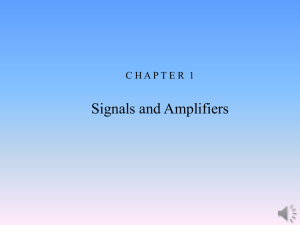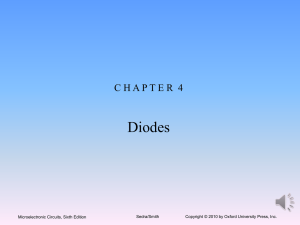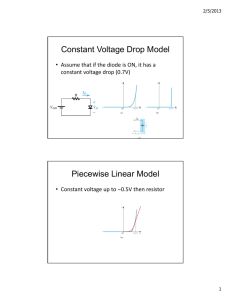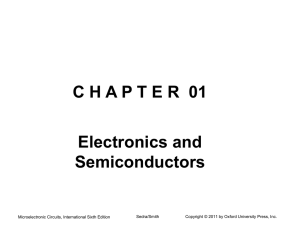Slide 1 - Oxford University Press
advertisement
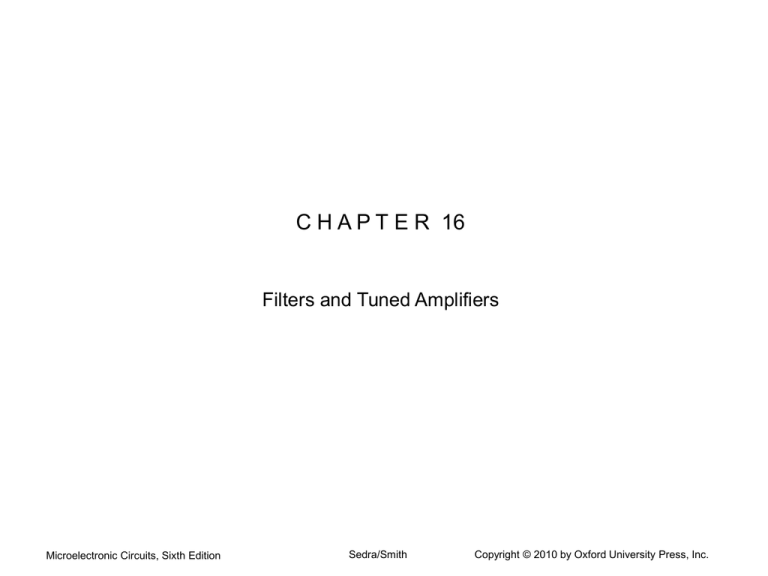
C H A P T E R 16 Filters and Tuned Amplifiers Microelectronic Circuits, Sixth Edition Sedra/Smith Copyright © 2010 by Oxford University Press, Inc. Microelectronic Circuits, Sixth Edition Sedra/Smith Copyright © 2010 by Oxford University Press, Inc. Figure 16.2 Ideal transmission characteristics of the four major filter types: (a) low-pass (LP), (b) high-pass (HP), (c) bandpass (BP), and (d) bandstop (BS). Microelectronic Circuits, Sixth Edition Sedra/Smith Copyright © 2010 by Oxford University Press, Inc. Figure 16.3 Specification of the transmission characteristics of a low-pass filter. The magnitude response of a filter that just meets specifications is also shown. Microelectronic Circuits, Sixth Edition Sedra/Smith Copyright © 2010 by Oxford University Press, Inc. Figure 16.4 Transmission specifications for a bandpass filter. The magnitude response of a filter that just meets specifications is also shown. Note that this particular filter has a monotonically decreasing transmission in the passband on both sides of the peak frequency. Microelectronic Circuits, Sixth Edition Sedra/Smith Copyright © 2010 by Oxford University Press, Inc. Figure 16.5 Pole–zero pattern for the lowpass filter whose transmission is sketched in Fig. 16.3. This is a fifth-order filter (N = 5). Microelectronic Circuits, Sixth Edition Sedra/Smith Copyright © 2010 by Oxford University Press, Inc. Figure 16.6 Pole–zero pattern for the bandpass filter whose transmission function is shown in Fig. 16.4. This is a sixth-order filter (N = 6). Microelectronic Circuits, Sixth Edition Sedra/Smith Copyright © 2010 by Oxford University Press, Inc. Figure 16.7 (a) Transmission characteristics of a fifth-order low-pass filter having all transmission zeros at infinity. (b) Pole–zero pattern for the filter in (a) Microelectronic Circuits, Sixth Edition Sedra/Smith Copyright © 2010 by Oxford University Press, Inc. Figure 16.8 The magnitude response of a Butterworth filter. Microelectronic Circuits, Sixth Edition Sedra/Smith Copyright © 2010 by Oxford University Press, Inc. Microelectronic Circuits, Sixth Edition Sedra/Smith Copyright © 2010 by Oxford University Press, Inc. Microelectronic Circuits, Sixth Edition Sedra/Smith Copyright © 2010 by Oxford University Press, Inc. Figure 16.11 Poles of the ninth-order Butterworth filter of Example 16.1. Microelectronic Circuits, Sixth Edition Sedra/Smith Copyright © 2010 by Oxford University Press, Inc. Figure 16.12 Sketches of the transmission characteristics of representative (a) even-order and (b) odd-order Chebyshev filters. Microelectronic Circuits, Sixth Edition Sedra/Smith Copyright © 2010 by Oxford University Press, Inc. Figure 16.13 First-order filters. Microelectronic Circuits, Sixth Edition Sedra/Smith Copyright © 2010 by Oxford University Press, Inc. Figure 16.14 First-order all-pass filter. Microelectronic Circuits, Sixth Edition Sedra/Smith Copyright © 2010 by Oxford University Press, Inc. Microelectronic Circuits, Sixth Edition Sedra/Smith Copyright © 2010 by Oxford University Press, Inc. Figure 16.16 Second-order filtering functions. Microelectronic Circuits, Sixth Edition Sedra/Smith Copyright © 2010 by Oxford University Press, Inc. Figure 16.16 (continued) Microelectronic Circuits, Sixth Edition Sedra/Smith Copyright © 2010 by Oxford University Press, Inc. Figure 16.16 (continued) Microelectronic Circuits, Sixth Edition Sedra/Smith Copyright © 2010 by Oxford University Press, Inc. Figure 16.17 (a) The second-order parallel LCR resonator. (b, c) Two ways of exciting the resonator of (a) without changing its natural structure : resonator poles are those poles of Vo/I and Vo/Vi. Microelectronic Circuits, Sixth Edition Sedra/Smith Copyright © 2010 by Oxford University Press, Inc. Microelectronic Circuits, Sixth Edition Sedra/Smith Copyright © 2010 by Oxford University Press, Inc. Figure 16.19 Realization of the second-order all-pass transfer function using a voltage divider and an LCR resonator. Microelectronic Circuits, Sixth Edition Sedra/Smith Copyright © 2010 by Oxford University Press, Inc. Figure 16.20 (a) The Antoniou inductance-simulation circuit. (b) Analysis of the circuit assuming ideal op amps. The order of the analysis steps is indicated by the circled numbers. Microelectronic Circuits, Sixth Edition Sedra/Smith Copyright © 2010 by Oxford University Press, Inc. Figure 16.21 (a) An LCR resonator. (b) An op amp–RC resonator obtained by replacing the inductor L in the LCR resonator of (a) with a simulated inductance realized by the Antoniou circuit of Fig. 16.20(a). (c) Implementation of the buffer amplifier K. Microelectronic Circuits, Sixth Edition Sedra/Smith Copyright © 2010 by Oxford University Press, Inc. Microelectronic Circuits, Sixth Edition Sedra/Smith Copyright © 2010 by Oxford University Press, Inc. Figure 16.23 Derivation of a block diagram realization of the two-integrator-loop biquad. Microelectronic Circuits, Sixth Edition Sedra/Smith Copyright © 2010 by Oxford University Press, Inc. Figure 16.24 (a) The KHN biquad circuit, obtained as a direct implementation of the block diagram of Fig. 16.23(c). The three basic filtering functions, HP, BP, and LP, are simultaneously realized. (b) To obtain notch and all-pass functions, the three outputs are summed with appropriate weights using this op-amp summer. Microelectronic Circuits, Sixth Edition Sedra/Smith Copyright © 2010 by Oxford University Press, Inc. Figure 16.25 (a) Derivation of an alternative two-integrator-loop biquad in which all op amps are used in a single-ended fashion. (b) The resulting circuit, known as the Tow–Thomas biquad. Microelectronic Circuits, Sixth Edition Sedra/Smith Copyright © 2010 by Oxford University Press, Inc. Figure 16.26 The Tow–Thomas biquad with feed forward. The transfer function of Eq. (16.68) is realized by feeding the input signal through appropriate components to the inputs of the three op amps. This circuit can realize all special second-order functions. The design equations are given in Table 16.2. Microelectronic Circuits, Sixth Edition Sedra/Smith Copyright © 2010 by Oxford University Press, Inc. Figure 16.27 (a) Feedback loop obtained by placing a two-port RC network n in the feedback path of an op amp. (b) Definition of the open-circuit transfer function t(s) of the RC network. Microelectronic Circuits, Sixth Edition Sedra/Smith Copyright © 2010 by Oxford University Press, Inc. Figure 16.28 Two RC networks (called bridged-T networks) that can have complex transmission zeros. The transfer functions given are from b to a, with a open-circuited. Microelectronic Circuits, Sixth Edition Sedra/Smith Copyright © 2010 by Oxford University Press, Inc. Figure 16.29 An active-filter feedback loop generated using the bridged-T network of Fig. 16.28(a). Microelectronic Circuits, Sixth Edition Sedra/Smith Copyright © 2010 by Oxford University Press, Inc. Figure 16.30 (a) The feedback loop of Fig. 16.29 with the input signal injected through part of resistance R4. This circuit realizes the bandpass function. (b) Analysis of the circuit in (a) to determine its voltage transfer function T(s) with the order of the analysis steps indicated by the circled numbers. Microelectronic Circuits, Sixth Edition Sedra/Smith Copyright © 2010 by Oxford University Press, Inc. Figure 16.31 Interchanging input and ground results in the complement of the transfer function. Microelectronic Circuits, Sixth Edition Sedra/Smith Copyright © 2010 by Oxford University Press, Inc. Figure 16.32 Application of the complementary transformation to the feedback loop in (a) results in the equivalent loop (same poles) shown in (b). Microelectronic Circuits, Sixth Edition Sedra/Smith Copyright © 2010 by Oxford University Press, Inc. Figure 16.33 (a) Feedback loop obtained by applying the complementary transformation to the loop in Fig. 16.29. (b) Injecting the input signal through C1 realizes the high-pass function. This is one of the Sallenand-Key family of circuits. Microelectronic Circuits, Sixth Edition Sedra/Smith Copyright © 2010 by Oxford University Press, Inc. Figure 16.34 (a) Feedback loop obtained by placing the bridged-T network of Fig. 16.28(b) in the negative feedback path of an op amp. (b) Equivalent feedback loop generated by applying the complementary transformation to the loop in (a). (c) A low-pass filter obtained by injecting Vi through R1 into the loop in (b). Microelectronic Circuits, Sixth Edition Sedra/Smith Copyright © 2010 by Oxford University Press, Inc. Microelectronic Circuits, Sixth Edition Sedra/Smith Copyright © 2010 by Oxford University Press, Inc. Figure 16.36 A pair of complementary stray-insensitive, switched-capacitor integrators. (a) Noninverting switched-capacitor integrator. (b) Inverting switched-capacitor integrator. Microelectronic Circuits, Sixth Edition Sedra/Smith Copyright © 2010 by Oxford University Press, Inc. Figure 16.37 (a) A two-integrator-loop, active-RC biquad (b) its switched-capacitor counterpart. Microelectronic Circuits, Sixth Edition Sedra/Smith Copyright © 2010 by Oxford University Press, Inc. Figure 16.38 Frequency response of a tuned amplifier. Microelectronic Circuits, Sixth Edition Sedra/Smith Copyright © 2010 by Oxford University Press, Inc. Figure 16.39 The basic principle of tuned amplifiers is illustrated using a MOSFET with a tuned-circuit load. Bias details are not shown. Microelectronic Circuits, Sixth Edition Sedra/Smith Copyright © 2010 by Oxford University Press, Inc. Figure 16.40 Inductor equivalent circuits. Microelectronic Circuits, Sixth Edition Sedra/Smith Copyright © 2010 by Oxford University Press, Inc. Figure 16.41 A tapped inductor is used as an impedance transformer to allow using a higher inductance, L’, and a smaller capacitance, C’. Microelectronic Circuits, Sixth Edition Sedra/Smith Copyright © 2010 by Oxford University Press, Inc. Figure 16.42 (a) The output of a tuned amplifier is coupled to the input of another amplifier via a tapped coil. (b) An equivalent circuit. Note that the use of a tapped coil increases the effective input impedance of the second amplifier stage. Microelectronic Circuits, Sixth Edition Sedra/Smith Copyright © 2010 by Oxford University Press, Inc. Figure 16.43 A BJT amplifier with tuned circuits at the input and the output. Microelectronic Circuits, Sixth Edition Sedra/Smith Copyright © 2010 by Oxford University Press, Inc. Figure 16.44 Two tuned-amplifier configurations that do not suffer from the Miller effect: (a) cascode and (b) common-collector, common-base cascade. (Note that bias details of the cascode circuit are not shown.) Microelectronic Circuits, Sixth Edition Sedra/Smith Copyright © 2010 by Oxford University Press, Inc. Figure 16.45 Frequency response of a synchronously tuned amplifier. Microelectronic Circuits, Sixth Edition Sedra/Smith Copyright © 2010 by Oxford University Press, Inc. Figure 16.46 Stagger-tuning the individual resonant circuits can result in an overall response with a passband flatter than that obtained with synchronous tuning (Fig. 16.45). Microelectronic Circuits, Sixth Edition Sedra/Smith Copyright © 2010 by Oxford University Press, Inc. Figure 16.46 Stagger-tuning the individual resonant circuits can result in an overall response with a passband flatter than that obtained with synchronous tuning (Fig. 16.45). Microelectronic Circuits, Sixth Edition Sedra/Smith Copyright © 2010 by Oxford University Press, Inc. Microelectronic Circuits, Sixth Edition Sedra/Smith Copyright © 2010 by Oxford University Press, Inc. Figure 16.48 Obtaining the poles and the frequency response of a fourth-order stagger-tuned, narrow-band bandpass amplifier by transforming a second-order low-pass, maximally flat response. Microelectronic Circuits, Sixth Edition Sedra/Smith Copyright © 2010 by Oxford University Press, Inc. Figure P16.11 Microelectronic Circuits, Sixth Edition Sedra/Smith Copyright © 2010 by Oxford University Press, Inc. Figure P16.27 Microelectronic Circuits, Sixth Edition Sedra/Smith Copyright © 2010 by Oxford University Press, Inc.
